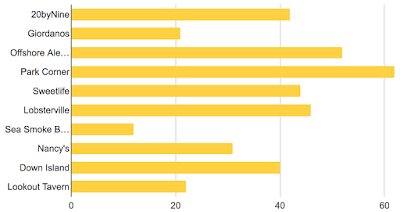Elections with a small number of voters can be tricky in terms of determining a winner in a reliable way. I experienced this recently in doing a KwikVote (our new website for doing quick polls) to select a restaurant for dinner among a group of 9 friends.
By small number of voters, I mean a small number of voters relative to the number of candidates or options. If you are deciding between two things (e.g., go out to dinner or stay home and cook), then the number of voters doesn't really matter, but if you are selecting a restaurant from 10 possible restaurants, then it is hard to get a good result with only 9 voters.
Here are the results of my restaurant poll using plurality voting:
Not only do we have a tie (which is more likely with a small number of voters) but no candidate has a majority. We could simply do a tie break to select a winner, but what if Giordano's was everyone's second choice? That might be a better outcome for the group.
Instant runoff voting allows you to select a majority winner and here is the last round of an IRV count:
In this round, 20byNine was eliminated and the vote transferred to Park Corner. Now we have a majority winner, but the results don't feel particularly satisfying. It is possible that Giordano's was the second choice of everyone else and that still might be a better outcome.
A ranked ballot gives us lots of information about the preferences of the voters, but we are using only the first choices of the voters and the second choice of the one voter who voted for 20byNine. Why not look at second or other choices on the ballot? Two other voting methods do this: Condorcet voting and the Borda count.
Here are the results using Condorcet voting:
This table shows who would win pairwise elections between the restaurants, and Park Corner is again the winner. The row for Park Corner shows that it beats all of the other restaurants and the margin of victory. Now we can be more confident that Park Choice is a good choice.
Here are the results using the Borda count:
With the Borda count, a candidate gets 9 points for a first choice, 8 points for a second choice, and so forth. Again, Park corner is the winner. Now we can be REALLY confident that Park Corner is a good choice.
In this example election, the four different voting methods produced the same result so Park Corner is the clear winner. In other situations, the methods may produce different results, and in these situations, it is useful to consider the Condorcet winner and the Borda count winner in ultimately deciding which restaurant to go to.
As a final note, it is worthwhile to compare elections with a small number of voters against elections with a large number of voters. For elections with a small number of voters (relative to the number of candidates), we need more information to make a good decision because there are many candidates to choose from. Plurality and IRV don't provide as much information about voter choices as do Condorcet voting or the Borda count, so these latter two may provide a better decision. If we are just selecting a restaurant (as opposed to electing a president) it makes sense to count the votes multiple ways to ultimately select a winner.
For elections with a large number of voters, we have a large amount of information regardless of which voting method we use. For these kinds of elections, it makes more sense to choose a voting method based on other merits of the system as opposed to just the amount of information used by the method as I've discussed here and here (and here and here).




